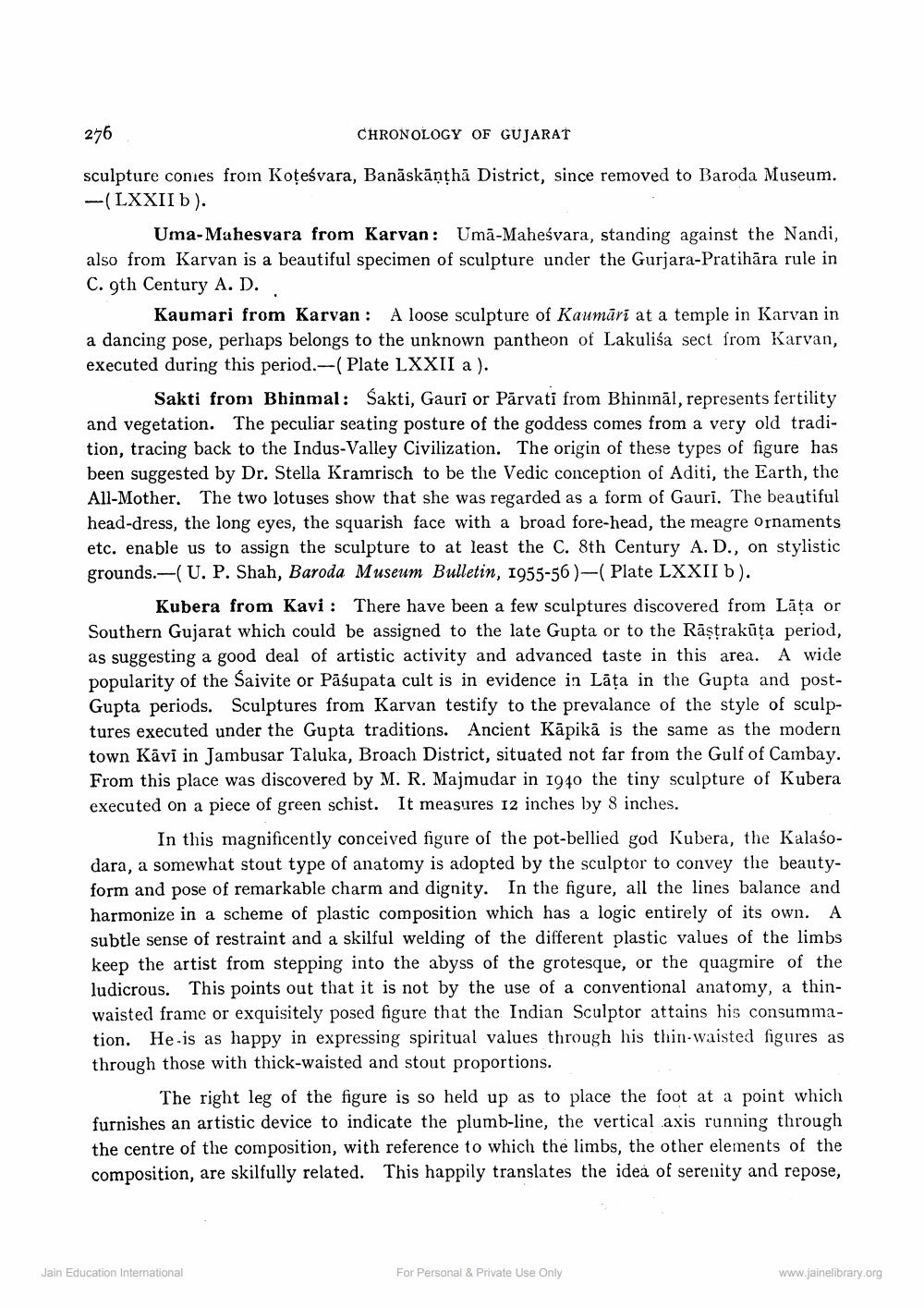________________
276
CHRONOLOGY OF GUJARAT
sculpture conies from Koțeśvara, Banāskānthā District, since removed to Baroda Museum. -(LXXII b).
Uma-Mahesvara from Karvan: Umā-Maheśvara, standing against the Nandi, also from Karvan is a beautiful specimen of sculpture under the Gurjara-Pratihāra rule in C. gth Century A. D.
Kaumari from Karvan: A loose sculpture of Kaumāri at a temple in Karvan in a dancing pose, perhaps belongs to the unknown pantheon of Lakulisa sect from Karvan, executed during this period.-(Plate LXXII a).
Sakti from Bhinmal: Sakti, Gauri or Pārvati from Bhinmal, represents fertility and vegetation. The peculiar seating posture of the goddess comes from a very old tradition, tracing back to the Indus-Valley Civilization. The origin of these types of figure has been suggested by Dr. Stella Kramrisch to be the Vedic conception of Aditi, the Earth, the All-Mother. The two lotuses show that she was regarded as a form of Gauri. The beautiful head-dress, the long eyes, the squarish face with a broad fore-head, the meagre Ornaments etc. enable us to assign the sculpture to at least the C. 8th Century A. D., on stylistic grounds.-U. P. Shah, Baroda Museum Bulletin, 1955-56)-( Plate LXXII b).
Kubera from Kavi : There have been a few sculptures discovered from Lāța or Southern Gujarat which could be assigned to the late Gupta or to the Rāştrakūta period, as suggesting a good deal of artistic activity and advanced taste in this area. A wide popularity of the Saivite or Pāśupata cult is in evidence in Lāța in the Gupta and postGupta periods. Sculptures from Karvan testify to the prevalance of the style of sculptures executed under the Gupta traditions. Ancient Kāpikā is the same as the modern town Kävi in Jambusar Taluka, Broach District, situated not far from the Gulf of Cambay. From this place was discovered by M. R. Majmudar in 1940 the tiny sculpture of Kubera executed on a piece of green schist. It measures 12 inches by 8 inches.
In this magnificently conceived figure of the pot-bellied god Kubera, the Kalasodara, a somewhat stout type of anatomy is adopted by the sculptor to convey the beautyform and pose of remarkable charm and dignity. In the figure, all the lines balance and harmonize in a scheme of plastic composition which has a logic entirely of its own. A subtle sense of restraint and a skilful welding of the different plastic values of the limbs keep the artist from stepping into the abyss of the grotesque, or the quagmire of the ludicrous. This points out that it is not by the use of a conventional anatomy, a thinwaisted frame or exquisitely posed figure that the Indian Sculptor attains his consummation. He is as happy in expressing spiritual values through his thin-waisted figures as through those with thick-waisted and stout proportions.
The right leg of the figure is so held up as to place the foot at a point which furnishes an artistic device to indicate the plumb-line, the vertical axis running through the centre of the composition, with reference to which the limbs, the other elements of the composition, are skilfully related. This happily translates the idea of serenity and repose,
Jain Education Intemational
For Personal & Private Use Only
www.jainelibrary.org




